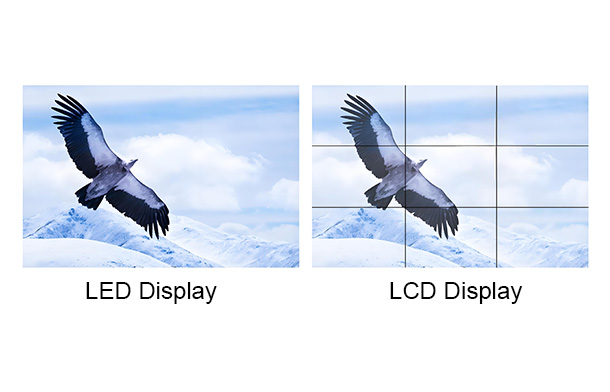 English
English
2025.03.17
In today's display technology landscape, LED and LCD screens are two of the most common types. While they share many applications, there are significant differences in their working principles, brightness, contrast, power consumption, size, and price. This article provides a detailed comparison of these two display technologies across these aspects.
The core of an LED display lies in the use of light-emitting diodes (LEDs). Each pixel in an LED display is composed of multiple LEDs that can emit light independently, allowing for direct image generation. Since the brightness of each LED can be controlled individually, LED displays typically offer richer colors and higher brightness.
In contrast, LCD (liquid crystal display) technology is based on the optical properties of liquid crystals. It utilizes a backlight source—usually fluorescent lamps or LEDs—to illuminate the liquid crystal layer. The liquid crystals themselves do not emit light; instead, they control the amount of light passing through by altering the polarization state, thus forming images. Because LCDs rely on a backlight, their display of black is generally not as deep as that of LED displays.
Display brightness directly impacts visual performance. Due to limitations in their light-emitting materials, LCD screens typically have lower brightness levels, especially struggling in direct sunlight. LED screens, however, use inherently bright LED chips and can opt for high-brightness LEDs to enhance visibility, delivering clearer and more vibrant images in bright environments.
Contrast ratio is an important metric in display technology that directly affects the viewing experience. LED displays can provide higher contrast due to their ability to control the brightness of each pixel independently. This results in deeper blacks and brighter whites, enabling more vivid images, which is especially important for watching videos and gaming.

While modern LCD technology has improved its contrast performance, it still lags behind LED displays, particularly in low-light conditions where the blacks may appear grayish due to the limitations imposed by the backlight.
In terms of power consumption, LED displays generally outperform LCDs. Thanks to the efficiency of LED technology, LED displays consume less power at equivalent brightness levels. This efficiency makes them a cost-effective choice for prolonged use, particularly in high-brightness applications like large-scale performances or outdoor advertising. In contrast, LCD displays tend to have higher power consumption at elevated brightness levels due to their backlight characteristics.
When it comes to size, LED displays offer greater flexibility. Since LED modules can be seamlessly combined, LED displays can be crafted into various shapes and sizes, even reaching very large dimensions suitable for outdoor advertising or major exhibitions. Although LCD displays are available in multiple sizes, they are often constrained by manufacturing processes, and larger LCD screens may face issues with seams during assembly.
In terms of price, LED displays are typically more expensive than their LCD counterparts of the same size. Even though products are similar, there can be significant price differences among various led display manufacturers. The higher manufacturing costs associated with LED technology, coupled with its greater brightness and contrast performance, contribute to the generally elevated market prices of LED displays. However, as technology advances and production scales increase, the prices of LED displays are gradually decreasing.
Conversely, LCD displays tend to have lower production costs, making them a more economical choice for budget-conscious users. However, buyers should consider long-term energy consumption and performance when making their purchase decisions.
In summary, LED and LCD displays each have their unique advantages and characteristics across various aspects. Consumers should choose the appropriate display technology based on their specific needs and budget. Understanding these differences can help users make informed decisions when selecting display solutions for their applications.